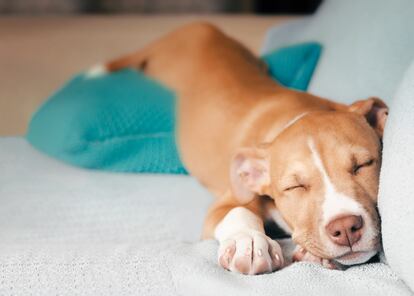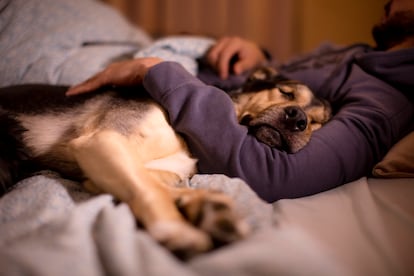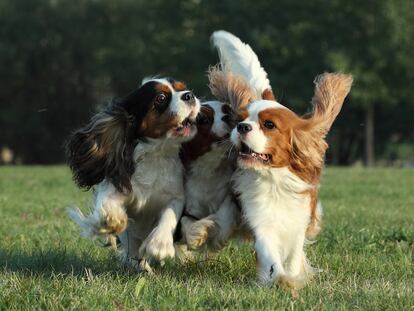Do dogs dream? What about?
Dogs experience dreams and nightmares where they recall waking moments, often provoking body movements and sounds during sleep

Dogs dream much like humans do. They go through the REM (Rapid Eye Movement) phase, marked by heightened brain activity. “Dogs typically enter the REM phase 20-40 minutes after falling asleep. That’s when their breathing is irregular, the eyes move and the body relaxes. But the mind becomes more active,” said Juan Antonio Aguado, a veterinarian at the Montepríncipe Clinic in Madrid.
People and dogs also share similar sleep patterns. “Humans don’t have a monopoly on dreams. The brain wave patterns indicating activity during rest are identical for both,” said Aguado. Dogs and humans relive what they experience when they are awake. “They probably dream about their owners, walks, toys or favorite foods during Slow Wave Sleep (SWS), the deepest sleep phase.” Aguado said SWS is characterized by “a lack of rapid eye movement and a slow oscillation of brain waves in the neocortex.” Canine dreams can provoke body movements and vocalizations. “When he clenches his jaws, he might be dreaming of catching a ball, snacking or licking his human. And when he tenses his legs, he might be reliving playful moments. Dogs often let out little whimpers and barks.”
Dog nightmares
Dogs may experience worrisome dreams, recalling frightening moments from their past. “Sometimes they might growl, bark or whine, and will wake up feeling defensive, scared or aggressive. It’s best not to wake them because they might attack, unable to tell dream from reality,” said Aguado.
Dogs are active during the day and an interesting fact is that they dream differently based on their size. “They sleep around 10 hours a day, mostly from 9pm to 6am, with occasional afternoon naps. Dream duration varies from one to 10 minutes based on the dog’s size,” said Aguado. “The larger breeds dream every 60 or 90 minutes, while the smaller ones do so about every 10 minutes. This is because little ones have more brain activity when they sleep.” Different dog breeds and sizes exhibit specific dream behaviors that differ in length and content. “Small dogs tend to have shorter and more frequent dreams than larger dogs. Breeds like the pointer can actually point to their prey, almost like they’re awake.”

Health problems can disrupt a dog’s sleep. “Osteoarthritis, heart and breathing problems, metabolic changes and age-related issues like cognitive dysfunctions similar to Alzheimer’s in humans can all affect a dog’s sleep.”
The benefits of dreaming
Dreaming supports mammal health by fulfilling biological functions. “It helps restore physical and mental functions for the next day. Sleep is crucial for memory retention and learning, which is why animals can dream like humans,” said Miguel Ibáñez, professor emeritus of veterinary medicine at the Complutense University of Madrid (UCM). People and animals don’t sleep just to dream. “Sleep is vital for survival – a sleepy animal will naturally seek out a secure place to rest,” said Ibáñez.
No studies have conclusively shown that animals are incapable of abstracting their experiences. “Animals do feel, assess and remember their thoughts for future use,” said Ibáñez. “Puppies sleep more than older dogs, but younger ones do so for shorter periods than older ones.”
Every creature possesses its unique manner of dreaming and resting. “When they’re in a deep sleep, they might snore or make sounds of contentment, like cats do when they purr,” said Ibáñez, who emphasized how crucial sleep is for the cognitive development of all mammals so they can adapt their environments.
Sign up for our weekly newsletter to get more English-language news coverage from EL PAÍS USA Edition
Tu suscripción se está usando en otro dispositivo
¿Quieres añadir otro usuario a tu suscripción?
Si continúas leyendo en este dispositivo, no se podrá leer en el otro.
FlechaTu suscripción se está usando en otro dispositivo y solo puedes acceder a EL PAÍS desde un dispositivo a la vez.
Si quieres compartir tu cuenta, cambia tu suscripción a la modalidad Premium, así podrás añadir otro usuario. Cada uno accederá con su propia cuenta de email, lo que os permitirá personalizar vuestra experiencia en EL PAÍS.
¿Tienes una suscripción de empresa? Accede aquí para contratar más cuentas.
En el caso de no saber quién está usando tu cuenta, te recomendamos cambiar tu contraseña aquí.
Si decides continuar compartiendo tu cuenta, este mensaje se mostrará en tu dispositivo y en el de la otra persona que está usando tu cuenta de forma indefinida, afectando a tu experiencia de lectura. Puedes consultar aquí los términos y condiciones de la suscripción digital.
More information
Archived In
Últimas noticias
Welcome to the post-religion era: The idea of Christianity as the absolute truth has become obsolete
‘I thought you would like it’: The risky sexual practice popularized by TV shows and TikTok
The digitalization of tourism: ‘They promise experiences and gave us the worst possible one’
Mexican peso defies uncertainty with forecasts of a new period of stability in 2026
Most viewed
- Sinaloa Cartel war is taking its toll on Los Chapitos
- Reinhard Genzel, Nobel laureate in physics: ‘One-minute videos will never give you the truth’
- Oona Chaplin: ‘I told James Cameron that I was living in a treehouse and starting a permaculture project with a friend’
- Why the price of coffee has skyrocketed: from Brazilian plantations to specialty coffee houses
- Silver prices are going crazy: This is what’s fueling the rally











































